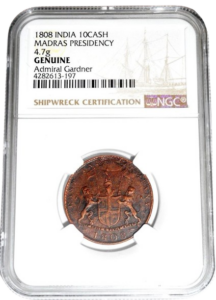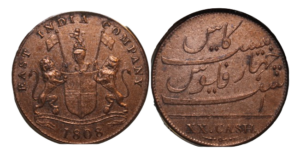The Admiral Gardner Coin Treasure
Posted on — Leave a commentThe Admiral Gardner was a significant vessel of the late 18th and early 19th centuries. Renowned not just for its role in the British East India Company’s trade, but also for its unfortunate end, the ship met a tragic demise in 1809 on Goodwin Sands. Admiral Gardner’s precious cargo of coins, salvaged years later, has been highly sought after by collectors ever since. This piece will uncover the full story of this iconic vessel, exploring topics such as Admiral Gardner shipwreck coin value and more, including:
- The significance of the 1808 Admiral Gardner shipwreck coin.
- What makes the 1809 Admiral Gardner shipwreck coin unique.
- Where to buy rare shipwreck coins online.
Watch this fascinating video about recovering the precious Admiral Gardner shipwreck coin cargo:
Admiral Gardner shipwreck story
Not to be confused with the Gardner island shipwreck, which took place in the Pacific Ocean and is often linked to the Amelia Earhart disappearance, the Admiral Gardner shipwreck occurred in 1809 on the treacherous Goodwin Sands. While it is true that the wreck is most famous for the 28,000 coins found on it, that is not even the most interesting fact about it. Here are some captivating facts about it, beyond the 1808 and 1809 Admiral Gardner shipwreck coin value:
- Ship name origin
The ship was named after Alan Gardner, the first Baron Gardner, who had a distinguished career in the Royal Navy before transitioning to political life as a Member of Parliament in 1796. Naming ships after prominent individuals to honor their contributions and legacy was a popular tradition at the time.
Alan Gardner was renowned for his leadership and strategic acumen as a naval officer. He participated in numerous naval engagements during the 18th century, including the American and the French Revolutionary Wars. The naming of Admiral Gardner after him honored his legacy as a respected naval commander and statesman of his era.
- Years of operation
The Admiral Gardner operated from 1797 to 1809. During its brief but impactful 12 years of operation, the ship played a crucial role in the transcontinental trade between Britain and the East Indies, carrying valuable cargoes and other goods essential to the economic interests of the British Empire during that period.
- Country of origin
The Admiral Gardner was built in 1796 in Blackwall, by the River Thames in Great Britain. It was specifically constructed and operated under the auspices of the British East India Company. Its home port of London, a bustling hub of commerce and naval activity, facilitated its voyages to and from the lucrative markets of the East Indies.
- Ship size
With a tonnage of 813 tons burthen, the Admiral Gardner was a substantial ship. It measured 44.4 meters in length overall, with a keel length of 36.1 meters. The ship had a beam of 11 meters, making it well-suited for transporting goods across long distances during its time in service.
- Ship function
Admiral Gardner was an East Indiaman. East Indiamen were large, sturdy sailing ships specifically designed for trade between Europe and the East Indies during the Age of Sail. These ships were operated primarily by European trading companies such as the British East India Company and the Dutch East India Company.
The Admiral Gardner’s primary role was to transport goods such as spices, silks, and porcelain, crucial for commerce between Europe and Asia during the late 18th and early 19th centuries.
- Shipwreck history
The English East India Company dispatched a fleet of ships to India and China annually. These ships carried valuable goods such as spices, textiles, and porcelain. One of them was the Admiral Gardner, which typically transported these essential trade items.
On January 24, 1809, Admiral Gardner set sail from London bound for Madras and Bengal as part of a convoy that included several ships. On that occasion, she was carrying a significant cargo of copper coins minted in England, intended for use in trade within the East Indies.
Unfortunately, the convoy of ships did not make it far before encountering a severe storm in the English Channel. Despite desperate efforts by the crew to save the vessel, she succumbed to the elements and was wrecked two days later, on January 26.
Buffeted by fierce winds, Admiral Gardner was driven onto the Goodwin Sands, a notorious stretch of submerged sandbanks off the coast of Kent, England. Alongside the Admiral Gardner, two other East Indiamen, the Britannia and the Carnatic, also suffered the same fate, getting wrecked onto the Goodwin Sands.
While historical records of the number of survivors vary, the Admiral Gardner captain and crew managed to reach safety, rescued by local lifeboats and vessels that braved the violent weather conditions to aid the stricken ship.
- Recovery
In 1984, a fisherman reported that his nets were repeatedly snagging on what was locally known as the wreck of the Admiral Gardner, leading to its discovery and subsequent recovery efforts. A team of divers located the remains of the vessel on the Goodwin Sands off the coast of Kent. They found the ship buried under layers of sand and silt, preserving much of its cargo and structure from the ravages of time. The ship’s cargo comprised primarily barrels of copper coins, along with cannon balls, anchors, iron bars, and copper ingots.
The primary focus of the recovery efforts was the vast quantity of copper coins minted by the British East India Company, which were intended for use in trade in the East Indies. The Admiral Gardner coin recovery operation was a meticulous process, involving careful excavation to avoid damaging the artifacts. The divers used advanced underwater archaeology techniques to map the wreck site and document the precise locations of the coins and other items. In the end, over 28,000 coins were recovered. All of them were remarkably well-preserved due to the protective sedimentary layers.
- Maritime preservation
The Admiral Gardner wreck site was designated as a Protected Wreck under the Protection of Wrecks Act 1973. This status recognizes its historical and archaeological significance, ensuring that any activities at the site are carefully managed and regulated.
In the late 180s, diving at the Admiral Gardner wreck site was suspended and no one is currently permitted to explore it. Located on the treacherous Goodwin Sands, the site posed significant risks to divers due to strong currents, shifting sands, and poor visibility. Moreover, there was growing recognition of the need to protect the wreck from unauthorized salvage operations and potential damage caused by unregulated diving activities.
Gardner rare coins to collect
In the mid 18th century, the Royal Mint struggled to meet the nation’s demand for bronze coins, which resulted in a shortage. Entrepreneurs saw a lucrative opportunity and, in response, began issuing privately minted tokens to fill the gap.
One such example was Matthew Boulton, who distinguished himself by producing high-quality tokens that gained widespread acceptance alongside official coinage. When issues emerged with the production of copper coinage in India, he was commissioned to make copper coins which would be later shipped out on Admiral Gardner.
While it is known that the Gardner coins never reached their intended destination, they were eventually recovered from the wreck site. They totaled 28,000 coins of two different types. This was unlike the SS Republic shipwreck coins, which included multiple types. Here is what we know about their historical significance and value.
1. 1808 Admiral Gardner coin
Minted under the direction of Matthew Boulton, this Admiral Gardner coin (1808) was intended for circulation in the East Indies. A stunning copper piece, it features a design of East India Company’s coat of arms on the obverse and the numeral “10” along the word “Cash” on the reverse. “10” indicates the coin’s denomination, while the term “cash” originates from the Tamil word “Kasu”, meaning “coin”.
In the early 19th century, due to the growing demands of trade and commerce within the British Empire, India was facing a significant currency shortage problem. For this reason, the Court of Directors instructed Great Britain to mint coins for them. More specifically, they authorized the production of a new series of copper coins, including denominations such as 20, 10, 5, and 1 cash, to replenish the circulating currency and stabilize economic transactions. Concurrently, the new Madras mint in India produced copper coins in 1807, ranging from 40 to 2.5 cash, aligning with local currency needs.
What makes the 1808 Admiral Gardner coin value especially high is its role in maritime history. Today, these coins serve as tangible relics of Britain’s colonial ambitions and economic pursuits in Asia. They are greatly sought after by collectors for offering insights into the intricate web of global commerce during the Age of Sail and their accessibility at reasonable prices, which makes them an ideal purchase for those interested in rare coin collecting on a budget.
However, it should be mentioned that collectors should exercise caution when purchasing this historic coin. With counterfeits of these coins increasingly prevalent in today’s market, it can be easy to buy an Admiral Gardner coin fake replica by mistake.
1808 Admiral Gardner Shipwreck 10 Cash coin NGC encapsulated
- Metal: Copper
- Year: 1808

Photo by PCGS
2. 1809 Admiral Gardner coin
Another remarkable relic of maritime history, the 20 Cash Admiral Gardner coin (1809) was also minted under Matthew Boulton with the intention of being circulated within the East Indies. Like its previous year predecessor, on the obverse, it features the distinguished East India Company’s coat of arms. The reverse displays the numeral “20”, indicating its denomination, alongside the inscription “Cash”.
Today, like 10 Cash coins, the 20 Cash Admiral Gardner coin is prized by collectors and historians alike for its historical context and numismatic value. It is particularly special because it showcases the craftsmanship of Boulton’s mint and the British Empire’s strategic use of currency in expanding its influence. These factors together enhance its 1809 Admiral Gardner coin value in numismatic circles.
20 Cash Admiral Gardner shipwreck coin (1809)
- Metal: Copper
- Year: 1809

To see more rarities, beyond Admiral Gardner shipwreck coins, click here.
Where to buy rare coins
The Admiral Gardner shipwreck and its recovered Admiral Gardner coins are poignant reminders of Britain’s maritime history and colonial ambitions in the East Indies. From their minting under Matthew Boulton to their recovery centuries later, these rare artifacts offer invaluable insights into global trade during the Age of Sail.
For those seeking exceptional coins like those from the Admiral Gardner, consider Blanchard. Contact Blanchard’s team for professional guidance on Admiral Gardner coin value and any other numismatic needs. They are dedicated to providing expertise and assistance whenever you require it.
Want to read more? Subscribe to the Blanchard Newsletter and get our tales from the vault, our favorite stories from around the world and the latest tangible assets news delivered to your inbox weekly








